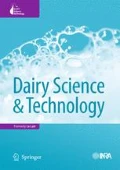Abstract
Eye formation is an important feature for various cheese varieties. This study firstly aimed to evaluate the potential of X-ray computed tomography (CT) and image analysis software as a non-invasive method to quantify cheese eye volume. The quantification of the eye volume by CT was validated with 12 eyeless hard cheeses made with the inclusion of 0–100 hollow PP balls (Ø = 10 or 20 mm). The results obtained for the total volume of the ‘artificial eyes’ showed a good correlation with the volume of the added balls (R 2 > 0.998). In a second part of the study, the developed CT method was applied for the non-invasive investigation of the eye formation in semi-hard Tilsit-type cheese with adjuncts of Lactobacillus casei or Lactobacillus plantarum. Both adjuncts completely metabolized citrate in cheese, thus enhancing gas production. Total eye number, relative eye volume and the size distribution of eyes were determined in order to reveal the influence of the two adjunct cultures on eye formation. In comparison to the control, the addition of L. casei resulted in a significantly higher eye number and eye volume. In contrast, the addition of L. plantarum did not influence the eye formation in a significant way, though it yielded cheeses with more succinate and aspartate and less serine at significant levels. The results imply that, apart from CO2 production, other factors, such as the presence of eye nuclei and the dynamics of CO2 diffusion, interfere in an important way in the process of eye formation in cheese.







Similar content being viewed by others
References
Akkerman JC, Walstra P, Van Dijk HJM (1989) Holes in Dutch-type cheese: 1. Conditions allowing eye formation. Neth Milk Dairy J 43:453
Albrecht B, Ulmann HR, Bosset JO (1998) Nachweis von Rissen in Käselaiben mit Ultraschall-Echografie. Dtsch Milchwirtsch 49:1162–1163
Badertscher R, Liniger A, Steiger G (1993) Bestimmung der flüchtigen Fettsäuren in Käse aus dem Wasserdampfdestillat mit ‘Headspace - GC/FID’ [Determination of volatile fatty acids in cheese by means of water steam distillation and Headspace - GC/FID]. FAM Info 272, Forschungsanstalt für Milchwirtschaft, Liebefeld-Bern, Switzerland
Bütikofer U, Ardö Y (1999) In: Int Dairy Fed (ed) Quantitative determination of free amino acids in cheese: chemical methods for evaluating proteolysis in cheese maturation, Bulletin of the IDF No. 337, Brussels, Belgium, pp 24–32
Bütikofer U, Fuchs D, Hurni D, Bosset JO (1990) Beitrag zur Bestimmung biogener Amine in Käse. Mitt Geb Lebensm Hyg 81:120–133
Caccamo M, Melilli C, Barbano DM, Portelli G, Marino G, Licitra G (2004) Measurement of gas holes and mechanical openness in cheese by image analysis. J Dairy Sci 87:739–748
Conde T, Mulet A, Clemente G, Benedito J (2007) Detection of internal cracks in Manchego cheese using the acoustic impulse-response technique and ultrasounds. J Dairy Sci 91:918–927
Dudley EG, Steele JL (2005) Succinate production and citrate catabolism by Cheddar cheese nonstarter lactobacilli. J Appl Microbiol 98:14–23
Eskelinen JJ, Alavuotunki AP, Haeggström E, Alatossava T (2007) Preliminary study of ultrasonic structural quality control of Swiss-type cheese. J Dairy Sci 90:4071–4077
Fröhlich-Wyder MT, Bachmann HP (2004) In: Fox PF, McSweeney PLH, Cogan TM, Guinee TP (eds) Cheeses with propionic acid fermentation: Cheese: chemistry, physics and microbiology, vol. 2, 3rd edn. Elsevier Academic, London, pp 141–156
Greco MK, Wechsler D, Fröhlich-Wyder M-T (2009) Preliminary investigations into eye development and cheese quality using X-ray computerised tomography. Rennes, France: Int Dairy Fed, Brussels, Belgium (IDF-conference in Rennes, 20–24. 4. 2009)
IDF (International Dairy Federation) (1993) Milk – determination of nitrogen content. IDF Standard 20b. Brussels, Belgium. Int Dairy Fed.
IDF (2001) Determination of the non-protein-nitrogen content. IDF Standard 020–4. Brussels, Belgium. Int Dairy Fed.
IDF (2003) Dry matter (Total solids). IDF Standard 4A. Brussels, Belgium: Int Dairy Fed.
ISO 3433:2008 (IDF 222) (2008) Cheese – determination of fat content – Van Gulik method. International Organisation for Standardization (ISO), Geneva, Switzerland
Isolini D, Grand M, Glättli H (1990) Selektivmedien zum Nachweis von obligat und fakultativ heterofermentativen Laktobazillen. Schweiz Milchwirtsch Forsch 19:57–59
Kraggerud H, Wold JP, Hoy M, Abrahamsen RK (2009) X-ray images for the control of eye formation in cheese. Int J Dairy Technol 62:147–153
Lee K, Uegaki K, Nishii C, Nakamura T, Kubota A, Hirai T, Yamada K (2012) Computed tomographic evaluation of gas hole formation and structural quality in Gouda-type cheese. Int J Dairy Technol 65:1–5
Linares DM, Martin MC, Ladero V, Alvarez MA, Fernandez M (2011) Biogenic amines in dairy products. Crit Rev Food Sci 51:691–703
Liu SQ, Holland R, Crow VL (2003) The potential of dairy lactic acid bacteria to metabolize amino acids via non-transaminating reactions and endogenous transamination. Int J Food Microbiol 86:257–269
Polychroniadou A (2001) Eyes in cheese: a concise review. Milchwissenschaft 56:74–77
Rosenberg M, McCarthy M, Kauten R (1992) Evaluation of eye formation and structural quality of Swiss-type cheese by magnetic resonance imaging. J Dairy Sci 75:2083–2091
Skeie S, Kieronczyk A, Naess RM, Ostlie H (2008) Lactobacillus adjuncts in cheese: their influence on the degradation of citrate and serine during ripening of a washed curd cheese. Int Dairy J 18:158–168
Thierry A, Berthier F, Gagnaire V, Kerjean JR, Lopez C, Noël Y (2010) In: Law B.A., Tamime A.Y. (Eds.), Eye formation and Swiss-type cheeses: technology of cheesemaking, Wiley-Blackwell, pp 360–383
Van den Berg G, Meijer WC, Düsterhöft EM, Smit G (2004) In: Fox PF, McSweeney PLH, Cogan TM, Guinee TP (eds) Gouda and related cheeses: Chemistry, Physics and Microbiology, vol. 1, 3rd edn. Elsevier, London, pp 103–140
Acknowledgments
The authors wish to thank Prof. Dr. Johan Lang from the Veterinary Faculty of the University of Bern, Department of Radiology, for CT collaboration and Karl Schafroth for the production of the different cheeses at the ALP pilot plant.
Author information
Authors and Affiliations
Corresponding author
About this article
Cite this article
Guggisberg, D., Fröhlich-Wyder, MT., Irmler, S. et al. Eye formation in semi-hard cheese: X-ray computed tomography as a non-invasive tool for assessing the influence of adjunct lactic acid bacteria. Dairy Sci. & Technol. 93, 135–149 (2013). https://doi.org/10.1007/s13594-012-0105-2
Received:
Revised:
Accepted:
Published:
Issue Date:
DOI: https://doi.org/10.1007/s13594-012-0105-2




